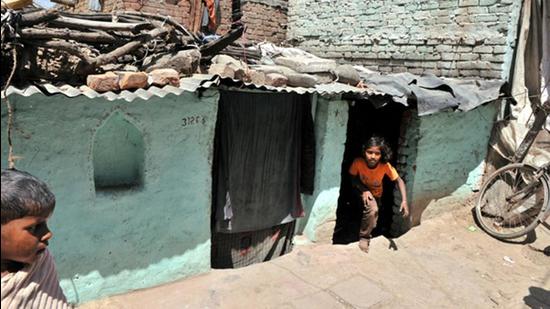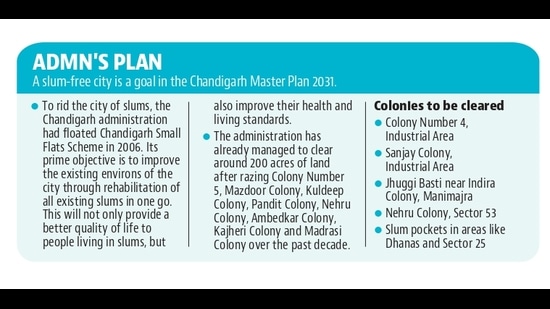Chandigarh to be made slum-free by March 2022
People eligible for resettlement will be relocated and others evicted after allowing due time to shift, says Chandigarh adviser
The UT administration has set March 2022 as the deadline for making the city slum-free, a major goal of the Chandigarh Master Plan 2031.

In a meeting with senior UT officials on Wednesday, UT adviser Dharam Pal directed that those eligible for resettlement should be resettled and others evicted after being given due time.
“The biggest site is Colony number 4 and other smaller pockets in the city will also be cleared by March 2022,” Pal said.
Notably, the administration has previously also set deadlines to rid the city of slums, twice, in 2010 and 2017.
The Estate Office has already reclaimed around 200 acres after razing Colony Number 5, Mazdoor Colony, Kuldeep Colony, Pandit Colony, Nehru Colony, Ambedkar Colony, Kajheri Colony and Madrasi Colony over the past few years.
But though sizable progress has been made, the goal still remains elusive.
“We should rehabilitate and resettle all 25,000 people identified by the biometric survey. But those who have settled later need to go. We will give adequate time to residents, two to three months, before forced eviction is undertaken by the administration. We cannot allow the process to linger on. The more it prolongs, more complicated it becomes,” said Pal.
Clearing out Colony Number 4 biggest task
Colony Number 4, in Industrial Area, is the second-biggest slum in Chandigarh after Colony Number 5, which was razed in 2013. While it originally housed over 7,000 people, the population is now down to around 5,000. Besides more slum pockets in Industrial Area, there are others in Manimajra, and Sectors 25 and 53.
The administration has conducted biometric survey twice, say UT officials.
The survey included thumb impressions, photographs, physical verification and voter identity card of residents seeking rehabilitation.
During the 2006 survey, a large number of residents were declared ineligible on the grounds that their names were not on voters’ list, while many residents were not present during physical verification.
Pal has directed the Deputy Commissioner (DC) office and the Chandigarh Housing Board (CHB) to coordinate on the issue. The DC Office gives the eligibility list to CHB that further allots the housing units.
Stating that the administration was also working on alternative housing options, Pal, said “We have the capacity and will examine under which schemes, like rental housing scheme, these arrangements can be made.”
Over the past year, CHB has rehabilitated slum dwellers from tin-shed colonies in Sectors 52 and 56 to the Rehabilitation Colony, Maloya, under the Chandigarh Small Flats Scheme 2006. It has also allotted around 2,500 flats to eligible residents of Colony Number 4 in Maloya. Around 500 flats are still vacant with CHB in Maloya.
Overall, the administration has constructed more than 40,000 units in different areas, including Maloya, Ram Darbar, Mauli Jagran and Dhanas.

Administrator briefed on Master Plan
On Wednesday, UT administrator Banwarilal Purohit also reviewed the Chandigarh Master Plan 2031 during a meeting with senior officials of the administration. The administrator was briefed on the master plan challenges, particularly the issues related to development and integration of 23 villages with the sectoral plan of the city.





